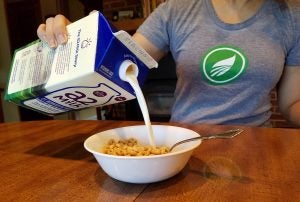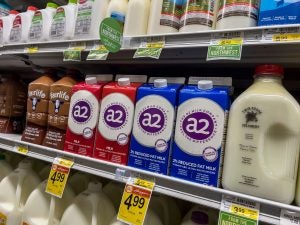From the treatment of the animals to the effect of dairy products on the human body, social media breeds a large amount of information that can paint the dairy industry in a negative light. With statements that are often being made related to dairy products — whether it be milks, cheese, yogurts, or more — there’s no surprise that it becomes increasingly difficult for shoppers and restaurant guests to know what to believe.
One of the major discussions in this space centers largely on what type of dairy is best for you –- so enters A2, which has made waves in recent years. This is because some studies show that milk with the A2 protein (rather than the A1 protein) is giving lovers of dairy a more digestively comfortable experience.
» Related: Top 7 U.S. dairy cattle breeds
So what exactly is A2 milk? Cow’s milk contains protein composed primarily of casein and whey. Casein protein includes three different types: alpha, beta, and kappa casein. Beta-casein is broken down into several types, but A1 and A2 beta-casein are the most common.
Though some stakeholders may argue otherwise, A1 and A2 protein milk are nearly identical with the exception of their position of one amino acid in the beta-casein protein chain: at chain 67, A1 has histidine whereas A2 has proline. Cow’s milk can contain A1 or A2, exclusively (A1A1 or A2A2), or a both (A1A2).
Traditional dairy cows used in large, commercial production are usually Holstein cows. This breed, and other common dairy cow breeds like Friesian, Ayrshire, and British Shorthair, typically contain the A1 beta-casein protein. This means that they have the A1 beta-casein protein or a combination of A1 and A2 beta-casein proteins.
In the past few decades, A2 milk has become more and more popular, primarily due to a mix of limited scientific research and anecdotal evidence that points to the A2 beta-casein protein being easier on the human digestive system. That type of milk, for the most part, comes from dairy cows that have predominately A2 genetics bred into their milk lines. The likely breeds that are used for A2 milk production are Jersey, Guernsey, Charolais, and Limousin. Newborn calves can be tested for the A2 protein using a DNA test using hair follicles.
Proponents of A2 milk argue that the A1 protein can cause gastrointestinal discomfort when lactose intolerance and allergies are ruled out. Some research supports the A2 beta-casein protein being more gentle on digestive systems; in particular, digestive systems that suffer from discomfort after consumption of conventional (A1) milk. For this reason, A2 milk has become popular for supposed lack of side effects after consumption.
This lack of side effects is disputed among experts, however. The National Dairy Council disagrees with advocates of A2 milk, contending that there isn’t enough research to prove unequivocally that A2 milk does what supporters say it does … or doesn’t. A 2018 AGDAILY article highlights the plea from A2 milk producers and distributors for the National Dairy Council to get on board the A2 train and combat “the trend of declining milk consumption being experienced by most of the world’s dairy milk markets.”
From 2020 to 2021, milk production has increased a little over 1 percent, with the number of dairy cows increasing by over 50,000 head. While fluid milk consumption in the U.S. has dwindled a bit in the past 10 years, consumption of cheeses other than cottage cheese has increased. Similarly, full fat ice cream consumption is down, but low- and non-fat ice cream consumption is higher. Overall, the consumption of dairy products has increased from 2010 to 2020, according to the U.S. Department of Agriculture. Even during the pandemic, when images of farmers dumping their milk supplies became commonplace, dairy consumption ultimately ended up increasing from 2019 to 2020 by 3 percent per person, mostly due to increased consumption in yogurt, ice cream, and butter.
Based on current data, all sign points to a continued upward trajectory of dairy consumption in the coming years.

So where does that leave the processing and distribution companies involved in A2 milk? And do they carry enough weight in this industry to drum up more support for A2 milk consumption?
One example is The a2 Milk Company, an Australian-based company that was founded in 2000 and sells milk exclusively containing the A2 beta-casein protein. On April 21, 2017, The a2 Milk Company’s market shares were worth $2.27. At the height of the pandemic, July 24, 2020, shares were worth $13.80. Late this summer, the market shares have dropped significantly to under $5.
The company has worked hard in recent year to gain a bigger foothold in the United States, and a few years ago, the company’s then-CEO spoke confidently of these efforts and of targeting California specifically because of it’s more “progressive” nature in terms of food advancements.
“Often a trend-setting state when it comes to health, wellness, and nutrition, California has been a strong market for lactose-free milk and plant-based beverages as an alternative to real dairy. We know this is a prime geography to lead Americans back to a real dairy option that provides all of the nutritional benefits of milk, without indigestion and discomfort,” that former executive said.
Fonterra Co-operative Group has teamed up with the a2 Milk Company and is also calling for the National Dairy Council to throw its support behind A2 production.

Even American-based companies at one point had aggressively adjusted operations to produce A2 milk. Prairieland Dairy out of Nebraska switched its operation over to A2 milk production in 2006, according to reporting done in November 2016. Interestingly though, Prairieland Dairy’s bottling and distribution operation was sold to Hiland Dairy less than a year later and is currently owned by Ohlde Family Farms. It is unclear why the multiple sales happened or what the company’s approach is related to A1 and A2 milk production.
Whether A2 or not A2, consuming any dairy products goes hand-in-hand with a myriad of health benefits: strong bones, decreased risk of osteoporosis, high levels of protein, calcium, and other nutrients. However, for those who have sensitivities to dairy, A2 milk may provide an (albeit pricier) solution without having to resort to milk alternatives such as those made with almonds or oats. A2 milk offers the health benefits and culinary experience of A1 milk, just with a decreased potential for some side effects such as digestive upset.
Certainly more research is required to determine whether A2 milk makes a difference to all consumers or just some, but the current research is promising. The good news is that whether a consumer drinks A1 milk or A2 milk, they will still reap the benefits consuming dairy.
Brianna Scott is a veteran farmer who lives in Eastern Washington while earning her Master’s of Science in Agriculture from Washington State University. She is active in the veteran ag community and raises poultry and livestock while growing a large market garden.



